School Safety and Security 2020: Is My Child Safe At School?
TLDR: Yes, your child is safe at school. But, not everywhere has the same school safety and security protocols. Schools have to deal with natural disasters, bullying, violence, and substance abuse. Now, school shootings are increasing. Each school handles active shooter incidents differently. Our recommendation is to have training for teachers and students, and lockdown devices.
Parents always want the best for their children.
In the times of the coronavirus, the question of whether or not they should send their children to school at all is the big question.
However, the virus is bound to go away eventually. And when it does, the normal concerns will return.
Parents take time to consider which school their children would go to. They check the school’s reputation and academic offerings. They check whether the school provides programs in which their child can progress.
Schools’ programs are no longer the top concern of parents nowadays. In North Little Rock, a survey showed that parents' top concerns are: school safety & security, student discipline, and teacher pay.
A safe learning environment helps improve children's abilities and improves their academic progress. School safety and security promotes learning.
But then, a big realization that most parents have is that school safety and security is a broader subject. It ranges from violence, harassment, bullying, and substance abuse. It also covers natural disasters such as hurricanes and earthquakes. Additionally, school shootings are now becoming a top concern from parents.
Although the coronavirus has stalled any new surveys, a survey created by Gallup.com in 2019 shows that 34% of parents are scared for their child’s physical safety when at school. Although Gallup.com did not refer to school shootings in their poll question, most parents thought of the August 2019 mass shootings when they answered it.

Source: Brenan, Megan. "Parents' Concern About School Safety Remains Elevated" | News.Gallup.com
Compared to 2018, the number of parents concerned about school safety was only lessened by 1%. In 2018, 35% of the parents answered yes to the same question on school safety. The poll was taken six months after the school shooting at Marjory Stoneman Douglas High School in Parkland, Florida.
In the past two decades, the lowest number of parents concerned about school safety (15%) was in August 2008. Other than that year, the average percentage is between 20% to 35%.
What Was The School Safety Situation Before?
According to FBI Special Agent Christopher Combs in his interview with CNN, there has been an active shooter event every other week in 2019. Every week, there’s horrifying news about active shooter incidents. When did this scary situation start?
Data on school shooting incidents wasn’t as detailed before the events in Columbine. The Center for Homeland Defense and Security’s data goes as far back as the 1970s. But, the definition of a K-12 school shooting incident was "each and every instance a gun is brandished, is fired, or a bullet hits school property for any reason, regardless of the number of victims, time of day, or day of the week."
It’s different from the FBI’s current definition of an active shooter situation. It's defined as "an individual actively engaged in killing or attempting to kill people in a populated area." So, even if there is data on shooting incidents from the 1970s, those cannot be read in the same way as the current data.
Based on public perception, schools are safe from shooting incidents before 1999. School safety and security was more focused on natural disaster management for fires and earthquakes. Violence in schools meant instances of bullying, and occasional student and teacher protests.
Despite these school safety and security concerns, there was no outspread fear from parents and students. If a school is known for its violence, parents would just choose to change schools.
In an interview for The Atlantic, Katreena Lloyd-Williams described school violence before as personal fights. She said, "You knew if you weren’t fighting with somebody, then you weren’t going to be a target."
Simply put, if you’re not looking for any trouble, you won’t get into any. That perception changed after the events in Columbine.
The Atlantic did a piece on high school life from the perspective of 2003 high school graduates. Laura Lineberger, a former 2003 graduate and now a teacher, talked about how she "never feared for a school shooting, ever" when she was still studying.
The 2003 graduates recalled security measures that were seemingly implemented overnight. One talked about being able to go through different entrances of the school buildings one day, and then getting redirected to limited entrances the next. Before 1999, most of the building’s doors were left unlocked during school hours.
Another school safety measure implemented after 1999 was the backpack ban. Nicole Martin, one of the featured parents, was shocked when her daughter requested one recently. She couldn’t believe that students are finally allowed to use backpacks in school.
(Although, the backpack ban is back after the Stoneman Douglas High School shooting in 2018. Some schools allow backpacks, but they must be clear or transparent for easy monitoring.)
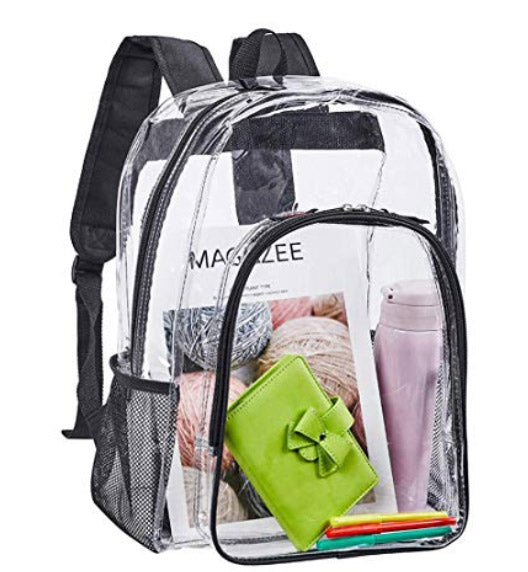
Source: Eland | Amazon.com
Aside from policy changes related to school security, parents and school administrators also focused on analyzing student culture and trends. They checked if any of those are indicators of future shooting incidents. Back then, The Matrix popularized wearing long black trench coats. Playing action video games were also popular. These pop culture trends were scrutinized and banned. There was even a ban on wearing all-black outfits to schools.
Schools implemented different policies, but it wasn’t clear whether it was effective.
How Did Schools Improve Safety and Security?
The National Center for Education Statistics (NCES) conducts research on Indicators of School Crime and Safety. The NCES asked what steps were taken in school years 1999-2000, 2013-2014, and 2015-2016.
The 2018 report stated that schools have taken necessary measures to improve school safety & security. These measures address concerns ranging from violence, substance abuse, crimes, and school shootings.
Schools implemented protocols such as locking or monitoring doors and gates, limiting access to school grounds, and installing tools such as CCTV cameras and metal detectors.
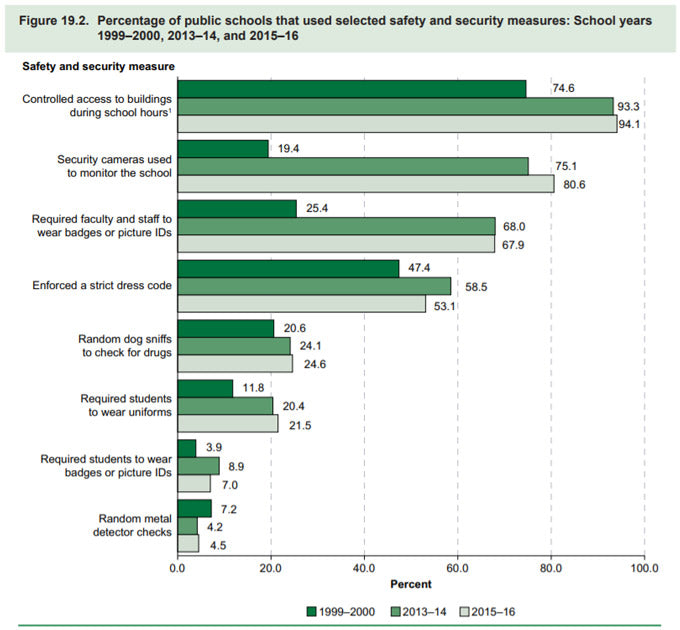
Source: U.S. Department of Education, National Center for Education Statistics, 1999–2000 and 2015–16 School Survey on Crime and Safety (SSOCS), 2000 and 2016; and Fast Response Survey System (FRSS), “School Safety and Discipline: 2013–14,” FRSS 106, 2014.
Schools have added security measures to ensure school safety and security over the years. Compared to the SY 1999-2000 data, 19.5% more schools limited access to school buildings. There is also a 61.2% increase in schools using security cameras as part of regular monitoring.
School districts requested more funds to improve infrastructure and security. In Georgia, $70 million was granted for security improvements. This gave them at least $30,000 per school.
In Michigan, Fruitport High School constructed a building with an innovative design. It showcased "wing walls." These specially-designed walls let students take cover and get out of the shooter’s line of sight. It also featured classrooms that provided hiding space for students and teachers. The construction of these school security features amounted to $48 million.
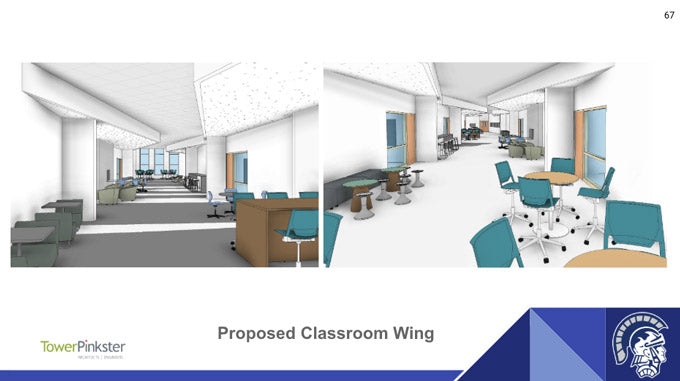
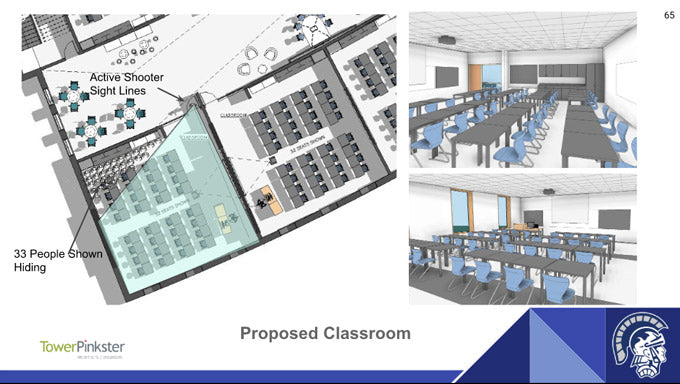
Source: “Initial Design Presentation” | Fruitport Community Schools
But, not all school districts have enough budget to renovate school buildings. In reality, even upgrading school door locks can rack up to $1,075 per door. Colorado school districts reportedly spent $4 million in upgrading door locks.
Even with the budget, some schools cannot change their classroom door locks. Public spaces, such as schools, must adhere to strict fire and building codes. Schools must find ways to secure doors without violating any of those codes.
Schools also focused on teaching how to respond to active shooting situations. In earthquake and fire drills, participants must get out of the building. Meanwhile, in active shooter drills, participants need to stay in lockdowns.
Based on the 2018 Indicators of School Crime and Safety, 95% of schools have drilled students on lockdown procedures. Public schools in Boston conduct two types of drills: safe mode and internal threat protocols. In SY 2015-2016, most public schools have written plans and drills to prepare for various emergency scenarios.

Source: U.S. Department of Education, National Center for Education Statistics, 2015–16 School Survey on Crime and Safety (SSOCS), 2016.
Some experts worry about overdoing active shooter drills. They claim that drills cause stress and trauma. Concerns stem from emotional stress and trauma that children get from participating. The purpose of the drills is to elicit an automatic response during high-pressure situations. Not conducting these drills lessens the chance for students and teachers to respond well when it happens.
Ultimately, training and drills, such as ALICE Training, save lives. The National Association of School Psychologists gave recommendations on how to conduct active shooter drills. They gave guidelines to ensure there's no inflicted trauma during the drills.
How Do Parents Feel About Today’s School Safety Situation?
According to FamilyEducation.com, your child is safer in school than any other place, excluding your home. Sometimes, the media focuses too much on the school shooting it spreads fear. But, this fear has led to parents being more aware of their children’s school environment.
Since the events at Columbine, parents are on alert whenever talks of school safety and security are involved. In 2016, there was a significant increase in parents’ involvement in K-12 schools based on the National Center for Education Statistics survey. 89% of parents attended general meetings and 79% attended school or class events.
Right after 1999, parent attendance in general meetings increased by 10%. Parents wanted to be more involved and informed about school safety and security.

Source: U.S. Department of Education, National Center for Education Statistics, Parent and Family Involvement in Education: Results from the National Household Education Surveys Program of 2016
It’s clear that parents are educating themselves more about school safety and security. They research and attend meetings to know more about the school’s environment. A study about private schools in 2018 showed that parents are choosing private schools over other schools because of their perceived security.
Based on the School Shooting Violence National Survey, six out of ten parents are worried about their children’s safety when in school. It goes to show that the majority of Americans consider mass shootings as part of school safety and security concerns.
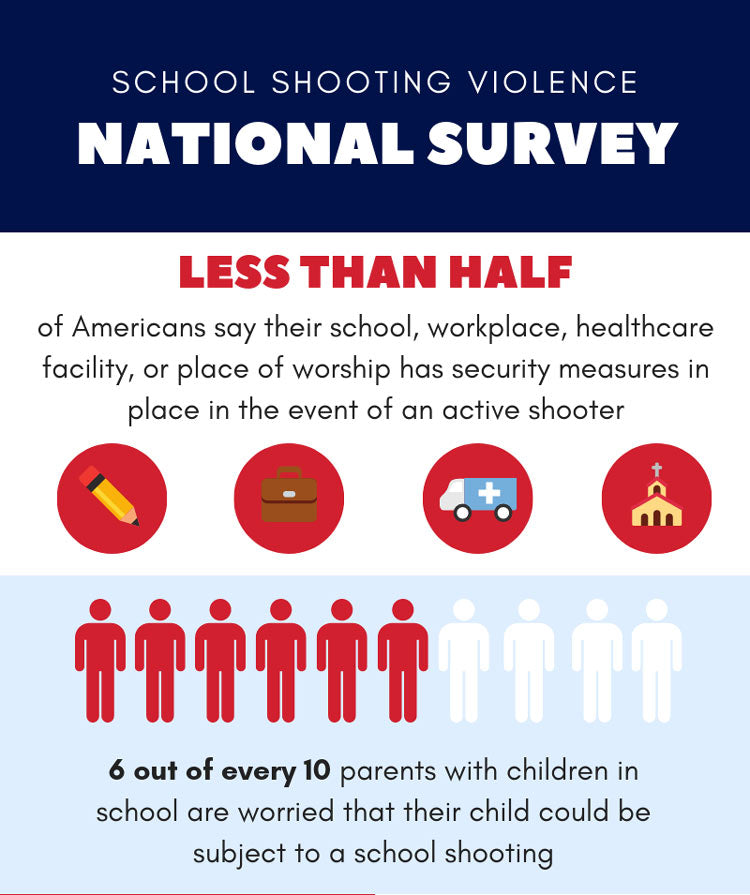

Parents are getting more involved to help the community and school safe. They are becoming more proactive and more eager to share solutions.
Parents’ involvement in promoting a safe and kind environment in schools is essential. Family engagement improves students’ achievements and ensures parents’ confidence in the school. Here are some actions that parents can do to improve school safety & security:
-

How to Improve School Security and Safety Tip #1 Be Physically Present
A parent’s presence is a key component of keeping the students in the school safe. Having more adult visibility helps reduce opportunities for violence. It lets offenders think twice about doing any security violations in school.
What does this mean? Showing up to the school to drop off or fetch your children is a good regular activity to do. Also, attending school events, and volunteering at school activities can help.
More than that, parents can observe and learn more about school safety and security when they are consistently present. Understanding the current school environment and situation helps parents find suggestions and solutions. This way, they can share it during Parent-Teacher Association Meetings or general meetings.
-

How to Improve School Security and Safety Tip #2: Talk To Your Child And Learn More About Their Environment
Talking to your child can help gauge if they feel safe in their school environment. These conversations also establish good communication and trust. Your child will be more open to tell you when they do not feel safe at school.
Ask them about their day, their teachers, and their classmates. Parents must be aware of who their child is interacting with on a daily basis. Learning more about your child’s classmates or teachers can also help you determine if there are signs of possible violent threats.
If you learn that another student or a teacher’s behavior seems different, you can talk to a trusted teacher or school administrator. They can find ways to help the troubled student or teacher.
-

How to Improve School Security and Safety Tip #3: Teach Your Child About Safety
Beyond school training, talk to your child about safety behaviors. Teach your child to report suspicious and dangerous behavior to proper authorities. Remind them not to talk to strangers and to find help from adults or any police officers around.
Additionally, learn more about your school safety and security protocols and measures. Finding out how your school handles different dangerous situations lets you know what reminders to reiterate to your child. Make sure that what you are teaching is not contradicting what they teach at school.
Talk to your child about what to do after the emergency is over, too. Tell them to call you to let them know they’re safe. Also, remind them to go home immediately or not to go anywhere until you fetch them.
-

How to Improve School Security and Safety Tip #4: Advocate For School Safety
Parents’ voice is essential now more than ever. Schools face budget cuts, which significantly slows down school safety and security improvements. School boards need to hear parents’ school safety and security concerns to help secure resources.
Aside from securing schools from cutbacks, parents’ suggestions and solutions should be heard during PTAs and general meetings. Work together with your school administrators to improve solutions for school security. Start the engagement by asking questions in your next parent-teacher meeting.
Help administrators improve school security protocols. Suggest affordable and easy-to-use security tools for every classroom. Encourage school administrators to improve classroom door security. Reiterate the need for response training. Hold your school accountable for their implemented security protocols.
Advocate for ALICE Training and Lockdown Devices
It’s been more than two decades since the events in Columbine. School security protocols and police response time have improved over the years. But, parents can still do more for their children.
During a high-tense situation, students and teachers must learn not to freeze and respond accordingly. Doing active shooter response training elicits automatic actions for when it happens. It lessens the need for students and teachers to think about what to do next when every second matter.
Schools are recommended to conduct drills multiple times a year. Similar to preparing for earthquakes and fires, students need to have muscle memory of what to do when there's an alert.
ALICE Training is a recommended active response training program for students and teachers. It provides deal response for handling an active shooter threat, drastically improving school safety & security. It stands for Alert - Lockdown - Inform - Counter - Evacuate.
During an active shooter situation, it is important to go on lockdown to stay away from danger. Students must immediately go to rooms. Barricade the doors to stop the intruder from coming in. Once the room is secured, the teacher (or a student) can call 9-1-1 to inform authorities about the threat.
When in lockdown, students and teachers stack chairs and desks against inward-swinging doors. They also use ropes and belts to secure outward-swinging doors. These methods take time and can produce a lot of noise, which may attract the attention of the shooter.
An intruder can also use force to break through the chairs, desks, and rope barricades. If the chairs and desks are not stacked correctly, the intruder could break through them. Ropes and belts can also rip once force is applied.
Security tools such as lockdown devices can help secure classrooms faster and easier. It helps secure the room in seconds, which gives time for everyone to find a safe hiding spot. Lockdown devices allow for peace of mind and relief during a stressful situation.
There are many different door security device types to help with classroom lockdowns. The Sleeve and the Rampart are two of the most affordable and reliable lockdown devices. Both lockdown devices are easy-to-deploy and affordable. They can enforce classroom doors to withstand 550 lbs. of external force.
Parents are encouraged to learn more about the ALICE Training and lockdown devices. Get a better understanding of what solutions you can advocate in your school. Here are some articles to help:
- How ALICE Training Saves Lives
- Why We Need Lockdown Devices For Classroom Doors
- Improving School Door Security For Emergencies
- 9 Door Security Device Types To Use In Lockdowns
Yes, children are safe at school. Especially when parents and school administrators help each other to create a good learning environment. There is no “one way” to deal with an active shooter situation. But, at the very least we should prepare teachers and students by conducting ALICE training and equipping classroom doors with lockdown devices such as The Sleeve and the Rampart.



